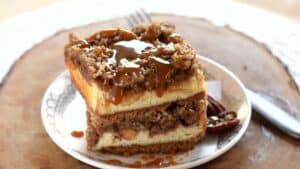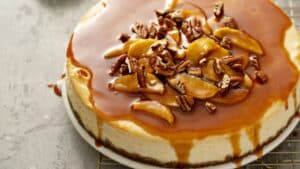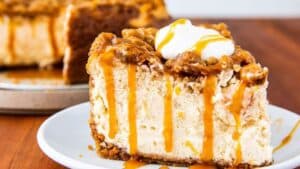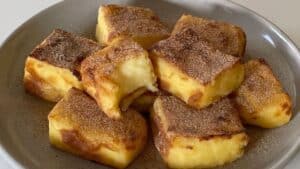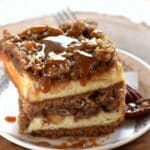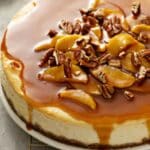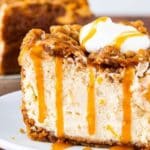Decadent Baklava Cheesecake Recipe
There’s something wildly rebellious about fusing two culinary icons into one unapologetically decadent dessert. Baklava cheesecake isn’t just a recipe it’s a cultural collision course, a buttery, syrup-soaked, nut-studded, cream-laced celebration. And done right, it will absolutely blow minds.
You’ve probably seen the idea floated around on Instagram reels or a random Pinterest scroll. But most of those recipes? Let’s be honest they miss the mark. They either lean too hard into the cheesecake and forget the filo or drown everything in a sugar bomb. You want balance. You want texture. You want something that says: this person knows their damn pastry. That’s where this guide comes in.
We’re diving deep into how to make a baklava cheesecake that honors both traditions and impresses the most jaded pastry snob. Whether you’re a seasoned pastry chef or a bold home baker who isn’t scared to turn the oven to 425°F, this is the blueprint.
What Even Is a Baklava Cheesecake?
Let’s get the definitions straight.
Baklava, for those who’ve never had the privilege, is a Middle Eastern and Mediterranean dessert made of layers and I mean layers of ultra-thin phyllo dough, brushed with butter, stacked with crushed nuts, and soaked in a fragrant honey syrup. It’s sticky, flaky, and hits you with cardamom, cinnamon, or rosewater depending on who made it.
Cheesecake, on the other hand, is creamy and indulgent, often baked over a graham cracker crust, but in this case, we’re giving graham the boot. Instead, phyllo becomes both the crust and the crown. It’s structural, yes, but also gives it that high-shatter crunch you want in every bite.
Why This Combo Works (And Why It Usually Doesn’t)
From a food science angle, this is a crazy marriage. You’re combining two very different moisture contents crispy filo that hates steam, and cheesecake, which is basically creamy steam.
A lot of recipes crash and burn here.
You get soggy bottoms, weird rubbery textures, or cheesecake that never sets. The key? Bake smart. Time your syrup. And don’t skimp on the butter. Butter is your armor.
Building Blocks: Ingredients That Matter
Before you even turn on the oven, your mise en place game has to be tight. This isn’t a throw-things-in-a-bowl kind of bake.
Phyllo Dough (or Filo, whatever spelling floats your boat)
Go for a high-quality brand. The frozen stuff from your local Greek deli? Probably better than the big-box freezer aisle. Thaw it overnight in the fridge not on the counter unless you enjoy heartbreak.
Nuts
Traditionally, baklava calls for walnuts or pistachios, but real talk: Use a mix. Toasted walnuts for base, pistachios for the finish. Some people even sneak in almonds, which adds body but not much flavor.
Butter
Unsalted, European-style. You want high butterfat content. Clarified butter is even better—no milk solids means no burning.
Cream Cheese
Go full-fat. This isn’t the time to be coy with calories. You want a brick, not a tub. Philadelphia brand works, but if you’ve got access to local artisan cream cheese? Do it. It’ll show in the texture.
Sweeteners
White sugar for the cheesecake base. Honey for the syrup. Not corn syrup. Not agave. Raw orange blossom honey is a flex, and people will notice.
Aromatic Addition
Think: cinnamon, a whisper of ground clove, lemon zest in the syrup, maybe a few drops of rosewater. Don’t go heavy-handed unless you want it to taste like grandma’s perfume bottle.
Recipe: The Proper Way to Build It
Prep the Phyllo Base
- Melt about 1 cup of clarified butter. Keep it warm.
- Lay 10-12 sheets of phyllo into a 9-inch springform pan, brushing each layer with butter. Let them hang over the sides like a pastry waterfall.
- Sprinkle chopped walnuts and cinnamon between layers if you’re feeling extra.
Pro Tip: Every sheet should sizzle a bit when butter hits it. If not, your butter’s too cold or your filo’s too dry.
Cheesecake Filling
- 3 (8 oz) blocks full-fat cream cheese, softened
- 1 cup granulated sugar
- 3 large eggs
- 1 tsp vanilla extract
- ¾ cup sour cream
- Pinch of salt
Beat the cream cheese until it’s smoother than your best excuse. Add sugar and beat again. Eggs go in one at a time. Then the sour cream and vanilla. Do not overmix. You don’t want too much air—that’s how cracks happen.
Pour this into your phyllo-lined pan.
Bake Like a Pro
Place the pan on a rimmed baking sheet—because leaks happen. Bake at 325°F (160°C) for 55–65 minutes. It should jiggle like the center of a crème brûlée, not like soup. Don’t open the oven. No peeking.
Cool in the oven with the door cracked for 1 hour. Chill overnight, uncovered. This step isn’t optional. It sets the structure.
Baklava Topping
Now comes the drama.
Layer 6–8 more sheets of phyllo on top of the chilled cheesecake, brushing with butter between each. Sprinkle chopped pistachios and walnuts in between, if you like crunch on crunch.
Bake again—this time just the top—at 400°F until golden, about 10–15 minutes.
Immediately pour over warm syrup:
- ¾ cup honey
- ½ cup water
- ½ cup sugar
- Strip of lemon peel
- 1 cinnamon stick
- Optional: few drops of rosewater or orange blossom
Simmer for 8–10 mins. Cool slightly, strain out solids, and pour over hot phyllo. Let it soak and settle for 2 hours before serving.
Common Mistakes and How to Dodge Them
Soggy Phyllo
You poured syrup on cold filo? Rookie move. Hot syrup meets hot pastry. End of story.
Runny Cheesecake
You didn’t chill it enough. Or worse, you cut it too early. Cheesecake is like revenge. Best served cold.
Dry, Crumbly Cheesecake
You overbaked it. Jiggle is not failure, jiggle is success. Fear the firm middle—it means you’ve gone too far.
Weird Flavor Clash
Too much rosewater, or using cheap artificial flavoring. Keep it subtle. Let the nuts and honey lead.
Expert Variations That Actually Work
Burnt Honey Baklava Cheesecake
Caramelize the honey syrup to just shy of burnt—think dark amber. Adds deep complexity, bordering on savory. Pair with sea salt finish.
Labneh Cheesecake Base
Swap half the cream cheese for labneh for tang and structure. Especially good with lemon-scented syrup.
Chocolate-Dipped Phyllo Shards
Make extra phyllo layers, bake separately, dip in dark chocolate, use as garnish. Very “cheffy” without being too precious.
Mini Versions
Use muffin tins with cupcake liners. Pipe the cheesecake base. One sheet filo per mini. Great for catering or plating in fine-dining setups.
Why This Dessert Sells (Hard)
On a restaurant menu, this thing kills. It hits nostalgia and novelty. It sounds exotic but is made of familiar parts. High perceived value, low food cost. Shelf life is great if stored chilled, and it’s stable for display.
According to a 2022 Technomic Dessert Consumer Trend Report, Middle Eastern flavor profiles are one of the top emerging trends in pastry innovation. This kind of fusion nails that demand.
Customers remember the crunch. The creamy contrast. The moment someone cracks that top filo with a fork, and hears the shatter? That’s gold. That’s drama on a plate.
Final Thoughts: What Makes It Decadent?
It’s not just the calories or the sugar content. Decadence is about excess done elegantly.
Layering crispy, buttery pastry with tangy, slow-baked cheesecake and fragrant honey syrup isn’t easy—but when you pull it off, it feels like you’ve engineered pleasure itself.
So go ahead, make it. For your pastry case. For your dinner party. For the pure indulgent joy of it. Just do it with intention. With technique. With a little sass and a lotta butter.
Your baklava cheesecake deserves to be legendary.


